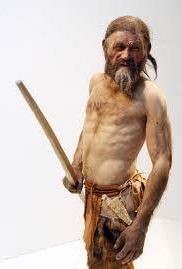In the early 1990’s a mummy was recovered in the Tyrolean Alps on the Italian-Austrian border. Based on radiocarbon dating techniques, the specimen turned out to be a man, nicknamed “Otzi,” who lived and died 5,300 years ago. Since its discovery it has undergone extensive examination. This plants him firmly in the Neolithic Era and is one of the earliest human specimens ever recovered.
We are fortunate that he was discovered at this time when medicine and forensic science has advanced to the point where we can even sequence his DNA. Every few years we are treated to some new revelation. First we learned that he was about 45 years old, 5’ 5” tall and weighted about 110 pounds. His lungs were blackened from years of breathing near the smoky fires of his small encampments. Next it appeared that he was murdered. Then we found out he suffered from many diseases, both chronic and acute. Such as whip worm, Lyme disease, as well as arthritis and arteriosclerosis. The latest finding is that he had bad teeth. Both decay and advanced Periodontitis.
Why did he suffer from so much disease when he lived in a pre-industrial and pristine environment? The answer is that thru all time humans have been at risk of infectious disease but the chronic disease, including tooth decay were a relatively new phenomenon. The state of preservation was so good we are able to determine what he ate and although meat, vegetables, and seasonal fruit were part of his diet beans and wheat were also a major component. We may think of 3,300 BC as very long ago and by human terms, it is but the roots of the tree of humanity runs much deeper. About 2.5 million years deeper. Otzi lived about 5,000 years after the Paleolithic Era ended. He carried not stone but a copper ax, clearly demonstrating a society with an advanced knowledge of metallurgy. Otzi was a grain eating agriculturalist and his body clearly demonstrates the damage that that lifestyle, without modern medical or dental care, does to the human body. Had he been a few thousand years older and entirely different picture of health would have emerged from the ice.
This quote from History.com fails to get it correct:
“The DNA analysis yielded especially intriguing evidence about Ötzi’s health. Though an active hunter-gatherer who never struggled with obesity, indulged in junk food or smoked a cigarette, the iceman was at risk for arteriosclerosis—a hardening of the arteries caused by fatty deposits and known to trigger heart attacks. “It is typically thought to be a modern, so-called ‘civilization disease,’” Zink noted. “With Ötzi we now know that the mutations already occurred more than 5,000 years ago.” If coronary heart disease predates unhealthy lifestyles, genetic factors might play a more significant role, making this leading killer even harder to control.”
Junk food and cigarettes are bad but beans and wheat break down to sugar. In your body this causes glycation and the formation of advanced glycation end products (AGE particles) and lead to inflammation which is the real killer. In your mouth your salivary amalyase breaks the starches into sugars which cause decay. What History calls “civilzation disease(s)” are in fact Neolithic diseases! This is an often overlooked but important distinction. Tooth decay is one of these diseases. Do not make the mistake of blaming genetics when the culprit is epigenetics and it is staring you right in the face.
Otzi was not some “caveman,” He was a member of an agricultural society living at a time without the benefits of modern medical care. Had he lived now his chronic conditions would have been managed. He would be on statin drugs and have a mouth full of dental restorations. Had he lived several thousand years earlier none would be necessary. That is the take home lesson here. We currently eat and live more like he did that the humans that came before. Like the cliché says, we can learn from the past or we can repeat it. The choice is ours to make.




Very interesting, John